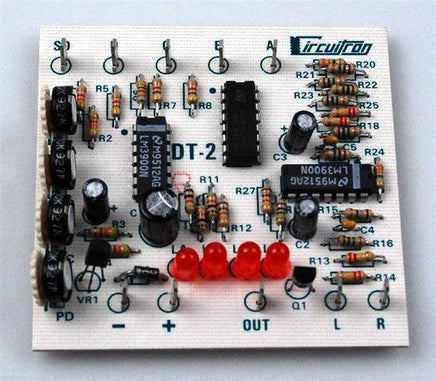
CIRCUITRON designed the DT-2 to be the most advanced DC track power grade crossing detection circuit available at any cost. It is completely independent of train length, and it will duplicate prototype grade crossing action for a single locomotive or a 100-car train. The DT-2 is completely bidirectional and includes the 4 Opto-Sensors required for a normal installation. The integrated circuit memory on the DT-2 does not require that a sensor remain covered in order to provide an output; the sophisticated circuitry will always maintain the output ‘ON’ for any length approaching train just until the last car clears the crossing. If a train should stop short of a crossing and then back away, the DT-2 will detect that, also, and turn the output ‘OFF’. The DT-2 is fully assembled on a 3” x 3” printed circuit board and will operate equally well from any 10-18 volt AC or DC power source. The output of the DT-2 provides a connection to the common or ground (-) side of the circuit and is capable of controlling DC powered loads up to 250 ma. Although the DT-2 is one of our more costly circuits, it is still an outstanding value for serious model railroaders who demand nothing less than the ultimate in realism for their layouts. Please see note regarding flashers above.
NOTE: If the DT-1 or DT-2 are installed on layouts using Command Control, the train direction sensing feature is defeated, and a manual panel switch must be used to establish the direction of travel prior to a train arriving at the crossing. Although this is somewhat clumsy, it is not much different from the prototype where a dispatcher must set the travel direction of signals on bi-directional trackage.
